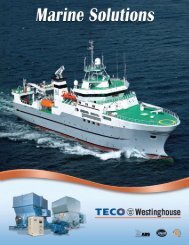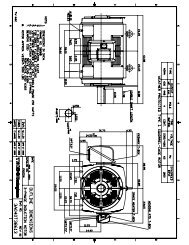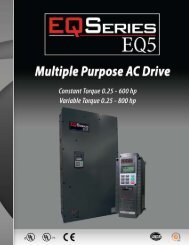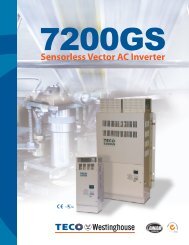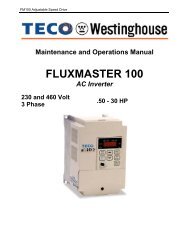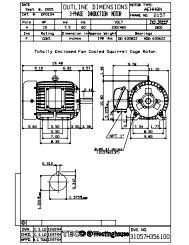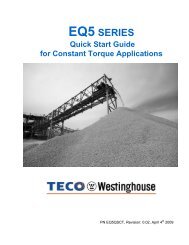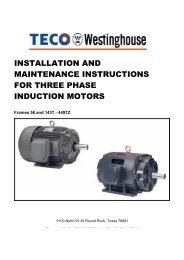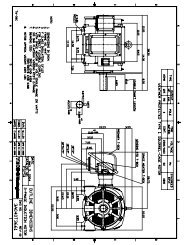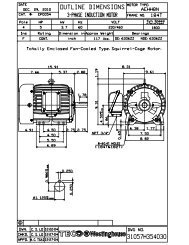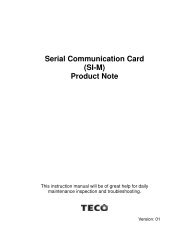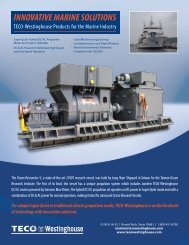EQ7 Series Instruction Manual - TECO-Westinghouse Motor Company
EQ7 Series Instruction Manual - TECO-Westinghouse Motor Company
EQ7 Series Instruction Manual - TECO-Westinghouse Motor Company
Create successful ePaper yourself
Turn your PDF publications into a flip-book with our unique Google optimized e-Paper software.
• High-speed motors<br />
If the reference frequency is set to 120 Hz or higher to drive a high-speed motor, test-run the combination of the<br />
inverter and motor beforehand to check it for the safe operation.<br />
Precautions for use on single-phase power<br />
An inverter is a device that converts alternating current of the input line to direct current via the ac-to-dc rectifier and<br />
then converts it to alternating current via the dc-to-ac switching inverter circuit in order to output the required<br />
alternating current. The <strong>EQ7</strong> drive is designed to connect to the three-phase power and this manual stipulates the<br />
specifications for the use on the three-phase power.<br />
If the inverter designed for connection to three-phase power runs on single-phase power, ripples (voltage fluctuation)<br />
on the DC link bus voltage rectified from the input power become larger than those in the inverter running on threephase<br />
power. The DC-voltage ripple affects the inverter output; that is, ripples could be superimposed on the output<br />
voltage or current, making control hard.<br />
Accordingly, the inverter may not work in full performance or function correctly. To use the <strong>EQ7</strong> drive on single-phase<br />
power, therefore, you need to take the following into account.<br />
• Output current<br />
Select the inverter capacity to keep the output current within the specified level, referring to chapter 11. Output current<br />
exceeding the limit extremely increases voltage ripples on the DC link bus, impeding normal operation or resulting in<br />
an inverter breakdown.<br />
• Wiring<br />
When connecting 230 V inverters of 60 HP or above or 460 V ones of 125 HP or above to single-phase power, use L1<br />
and L3 phases since cooling fans and magnetic contactors inside the inverter are supplied with power via L1 and L3.<br />
Using L2 does not work cooling fans or magnetic contactors, causing abnormal heat, in the worst case, resulting in an<br />
inverter breakdown.<br />
• Connecting peripheral devices<br />
For the specifications of circuit breakers and fuses to apply, refer to pages 1-6 and 1-7.<br />
• Configuring function codes<br />
(1) Cancel the input phase loss protection of the protection/maintenance function with function code H98 (Bit 1 = 0).<br />
This is because the inverter judges single-phase power as a phase loss.<br />
(2) Limit the drive mode to the VT / CT-V mode (Function code F80 = 0 or 1).<br />
(3) Do not use "Vector control without speed sensor" or torque control. (Function codes F42 5, H18 = 0)<br />
(4) "V/f control with slip compensation inactive" is recommended (F42 = 0). Any other drive control calculates the<br />
motor model using the motor parameters inside the inverter. As ripples on the DC link bus voltage become larger,<br />
therefore, calculation causes some errors so that the inverter may not provide the desired performance. Consider<br />
this problem before use. In particular, when using "Vector control with speed sensor" (F42 = 6), dancer control<br />
(J01 = 3), or brake signals (J68, J69, J70, etc.), assure the operation and safety of those speed sensors.<br />
1-11



